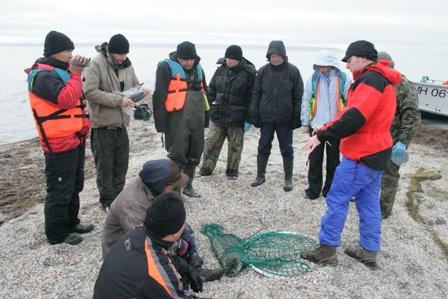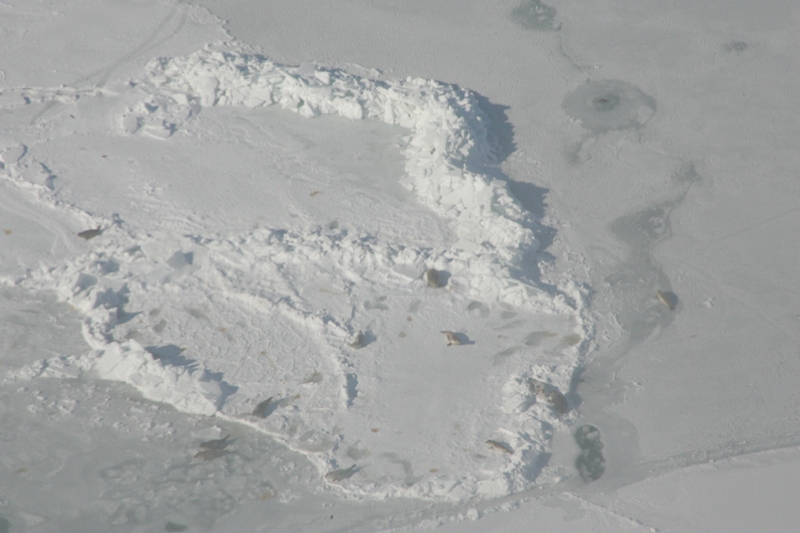Caspian Seal Project

The Caspian seal is endemic to the Caspian Sea and its population has decreased by more than 90% since the start of the 20th Century. The population continues to decline due to threats arising from human impacts on the Caspian Sea ecosystem, and the species is now listed as Endangered on the IUCN red list.
The Caspian seal project is a conservation initiative involving scientists from each of the five countries surrounding the Caspian (Iran, Azerbaijan, Russia, Kazakhstan and Turkmenistan) together with specialists in seal science from the international community, currently from the UK, Sweden, Estonia and Russia. Since 2000 the project has been funded by grants from the World Bank/Japanese Government Trust Fund, the UNDP/Global Environment Fund (GEFII) UNDP and by Agip KCO. Since July 2006 the project has been supported by the UK Government Darwin Initiative and the Kazakh Fisheries Research and Production Centre. The project works with Caspian government bodies and other stakeholders in the region to disseminate research findings and develop conservation policy.
Mission Statement
Our aim is to define the status of the Caspian seal population, and identify and respond to threats to the seals
- Monitor the annual pup production
- Determine Caspian seal population trends
- Monitor seal distributions and identify key habitat areas
- Monitor health status of the population along with causes and rates of mortality
- Develop and implement a seal conservation action plan
- Enhance the capacity in the region for seal conservation biology
- Raise the profile of the Caspian seal as a flagship species for the Caspian
 |
 |
|
 |
|
News items
IUCN change Caspian seal red list status to Endangered
On Ocotber 6th 2008, as part of the red list review of mammals at risk of extinction, IUCN (International Union for Conservation of Nature) announced that Caspian seals have been moved from 'Vulnerable' to the more serious risk category 'Endangered'. Work conducted by the project contributed to this reevaluation. {docs}caspian-seal-press-release06-10-2008{/docs} , and the new IUCN red list entry here.
New Caspian seal paper published
The results from the project's 2005 and 2006 aerial population surveys are published in the July 2008 edition of the scientific journal Ambio.
Pup production survey, February 2008
The fourth survey of breeding seals on the north Caspian ice was carried out by the CISS team in February 2008, under contract to Agip KCO. 2008 was an excellent ice year, being one of the coldest winters for a long time. The numbers of pups and adults on the ice this year should therefore give a good estimate of the current pup production. The results indicated that there were about 7,000 pups on the ice this year, and about 25,000 adults.
The pup numbers in the previous surveys have been approximately 21,000 in 2005, 17,000 in 2006 and 6,000 in 2007. We initially thought that the very low number in 2007 may have been due, at least partly, to the warm winter and very poor ice conditions that year. However, the similarly low number for 2008 - a good ice year - suggests that this low pup production appears to be largely independent of ice conditions. Our figures for pup numbers indicate that pup production has fallen by about 60% since 2005.
The number of adults on the ice has also declined by about 30% in the past few years, from about 35,000 in 2006 to about 25,000 in 2006, 2007 and 2008.
February 2008 Diagnostic tests on pups dead in Kazakhstan in spring fail to confirm distemper virus, 2007
Preliminary reports on diagnostic tests (using antigen capture technique) carried out by the Institute of Virology and Microbiology in Kazakhstan on six dead pups in early April 2007 suggested that the mortality may have been due to canine distemper virus (CDV). However, further diagnostic testing of tissues from these pups by two more definitive methods have failed to confirm the presence of the virus. The tests used were carried out by the same methds and laboratories that diagnosed the CDV epidemic in 2000, i.e. immunohistocehmistry (IHC), carried out in the Veterinary Sciences Division, AFBINI, N. Ireland) and polymerase chain reaction (RT-PCR) at the Institute of Animal Health, Pirbright, England.
Further seal monitoring throughout the Caspian during 2007 did not result in the finding of any large-scale mortality indicating infectious disease. One young seal washed up dying on the shore of Iran was diagnosed with severe pneumonia, but was negative by IHC for the distemper virus. Other dead seals have been found singly throughout 2007 and early 2008, but not in the concentrations indicating infectious disease, and at least some of these seals died during interactions with fishermen. Interviews with fishermen in Kazakhstan have indicated that young seals trapped and drowned in sturgeon nets may amount to several hundred at a time - we suspect, therefore, that this may have been a cause of the spring 2007 mortality.
Hormoz Asadi
It is with great shock and sadness that we have to announce the tragic and untimely death of our dear colleague, Dr Hormoz Asadi, on January 10th 2008. Hormoz died in a traffic accident while returning home from field conservation work in Isfahan Province in Iran. Hormoz was irreplaceable, and we do not know what the project, or the seals, will do without him. We extend our sympathy to his wife, Maheen, in her terrible loss.
A Darwin workshop was held in Bautino, Mangyshlak Peninsula, November 9-17, 2007

Scientists from Kazakhstan, Turkmenistan, Azerbaijan, Russia, Estonia and the UK gathered at Bautino to participate in a feasibility study for fieldwork. We had hoped to catch two pregnant female seals in order to attach a satellite tag to each, which would have enabled us to follow their movements as the ice formed and as they took up their pupping locations on the ice, and then their movements on the ice and in the water while they cared for their pups. Unfortunately we didn't catch any pregnant females, so we have to keep the tags until there is another opportunity. We did, however, find a group of seals which were mainly juveniles, and we were able to catch several of these little seals, and from each we took a blood sample and swabs in order to test for any virus antibodies. After sampling - which took just a few minutes - the seals were immediately released unharmed. We were also able to collect seal faecal samples from the beach where the seals were resting, and from analyses of these we were able to conclude that the little seals were eating mainly small gobies together with a few shrimps!


Group of juvenile Caspian seals studied in November 2007 Seal released after blood sample taken, November 2007
Seal Festival in Iran, August 2007

A wonderful seal festival was held in Guilan Province, northern Iran, in August 2007. The Darwin seal project team in Iran, together with the Caspian Environment Programme organised the event which found a large and enthusiastic crowd of children and adults all coming together under a flying seal balloon (dnated by CEP). Chidren rode on floats, payed with seal toys, made model seals out of clay and heard speeches made by Dr Hamid Ghaffarzadeh of the CEP and Dr Hormoz Asadi of the Darwin Caspian seal team.




Caspian seal juvenile mortality in Kazakhstan, April 2007
At the beginning of April, 2007, there were reports of over a hundred seal carcases, washed ashore on the northern coast of the Mangyshlak Peninsula in Kazakhstan. Two virologists from the Kazakh Institute of Microbiology and Virology and two biologists from the Centre for Fisheries Research and Production and Darwin team - immediately went to the scene on April 3-4 and found 161 carcases, mainly pups of the year (approximately 6-8 weeks old). The post-mortem examinations and analyses found that the pups were generally in good body condition, and preliminary analyses indicated that the cause of death was canine distemper virus (CDV). Over the next month the number of dead seals counted rose to 928, of which 710 were reported to have been pups. However, no further large-scale mortality was reported after the beginning of May, and the mortality was not reported to have spread to other parts of the Caspian. Further analyses of tissue samples collected in early April are currently being carried out at UK laboratories.
The 3rd CISS aerial population survey, February 2007
The third annual survey of the seal breeding population on the winter ice-field was successfully carried out in the last week of February by the CISS team. The ice conditions were unusual this year – there was no ice in Russian waters, and only a narrow fringe of ice in the north-eastern part of Kazakhstan waters, which did, nevertheless, apparently provide sufficient ice habitat for the breeding seal population. This scenario was somewhat complicated by a storm occurring on 21st February, which cause some of the seal ice to be broken up and to drift, and probably caused the deaths of some pups. This storm was immediately followed by a spell of freezing temperatures, causing a new thin ice sheet to surround the old drifting ice. Nevertheless, the team was able to survey all of the areas where there was old ice, and therefore to count all of the ice habitat where there could be adult seals and surviving pups.
 |
 |
|
The BISRAG meeting September 23-24th 2006
This meeting of stakeholders in the region (Biodiversity and Invasive Species Regional Advisory Group, BISRAG) dedicated half a day on September 24th to listening to a presentation from the CISS team’s Mart Jüssi on the population status of the Caspian seal, followed by a discussion on the 2nd draft of the Seal Conservation Action and Management Plan (SCAMP) prepared by the CISS team in 2005 and reviewed by the Darwin scientific partners. This draft was then taken forward and amended slightly in the light of views from the BISRAG members to form a third draft. This 3rd draft was reviewed and then accepted at the Caspian Environment Programme (CEP) Steering Committee Meeting (SCM) held in Moscow on December 5/6, 2006.
The Darwin seal project 1st workshop was held in Baku, Azerbaijan, during the week of September 18-22, 2006.
This meeting focussed on lectures on Caspian seal biology and practical training for scientists in the methodologies to be used throughout the Darwin project in post-mortem examination and sampling and live-sampling techniques. Specialists from the UK (Paul Jepson, UK marine mammal stranding project, Institute of Zoology in London, and Callan Duck, Sea Mammal Research Unit) and Estonia (Mart Jüssi) gave the principal presentations. Theory was interspersed with practical field trips, using the new project boat, to the island near Baku. Unfortunately – and unexpectedly – no seals were found on the island.
The Darwin seal project initial meeting for the principal scientific partners in each Caspian country was held in Baku, Azerbaijan, in September 13-16th, 2006.
During this meeting the scientific partners were able to meet each other and exchange information. The outline project activities were reviewed and agreed by all the project partners. Very importantly, the partners were able to review in detail and agree the 2nd draft of the regional Seal Conservation Action and Management Plan (SCAMP). This was then ready to present to stakeholders in the region able to take decisions on acceptance and implementation.

